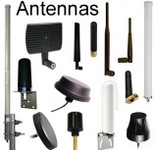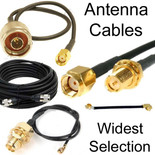Antennas, Antenna Cables, Wireless Products: Technical Articles
ZigBee Compared to Bluetooth and Wi-Fi for IoT Applications
ZigBee Compared to Bluetooth

Bluetooth and ZigBee are closer competitors as they are both used for personal area networking and operate at the 2.4 GHz frequency. They are also both low power. Bluetooth's networking standard IEEE 802.15.1 differs from 802.15.4 which covers ZigBee in a number of ways.
Bluetooth is definitely more recognized than ZigBee and its protocol in a wide range of devices, making it easy and convenient to use. Though the energy consumption of Bluetooth is low, it is designed to be used in devices that are frequently recharged. The batteries of devices using ZigBee technology can run for years off a single charge because its energy use is so low. This makes the ZigBee protocol particularly sought after for IOT applications.
Bluetooth has less coverage than ZigBee, with distances that are often only a few meters depending on conditions. With optimum conditions, ZigBee can operate over distances up to 100 meters, around 10 times the range of Bluetooth. It also has greater penetration - Bluetooth is not effective at penetrating walls, which is a limitation for smart home applications. But when used for strictly personal area networking, data transfer rates are faster for Bluetooth with a bitrate of 345 kbps versus only 250 kbps for ZigBee.
Modulation techniques also vary with Bluetooth using Gaussian frequency Shift Keying and ZigBee reliant on offset quadrature phase-shift keying (OQPSK) at 2.4 GHz and low energy Ultra Wideband. The simplicity of ZigBee makes it remarkably scalable with a maximum number of cell nodes, individual units of connectivity, for the network exceeding 60,000, versus only 8 for Bluetooth's point to multipoint mesh networking. This difference in scale really shows up how these two technologies vary in application; Bluetooth is better suited to cable-free personal use and has better mobility, whereas ZigBee can be used for more expansive automation-based networks where embedded devices are remotely controlled.
ZigBee Compared to WiFi for IoT
Though ZigBee and WiFi can operate in the same frequency band, they are two distinct types of wireless communication and are usually used for differing purposes.
Wifi advantages and disadvantages are eclipsed by ZigBee's demonstrable performance as a wireless personal area networking (WPAN) technology and when it is well-aligned to an application, it can exceed WiFi in a number of areas.
ZigBee is designed for monitoring and control applications that require movement of much less data over far shorter distances than WiFi. This is reflected in ZigBee's lower bitrate (250kbps), bandwidth (of just over 1 MHz), and short distances over which it operates.
ZigBee's mesh networking standard differs from WiFi, a WLAN technology that has a star topology, with each networked device connected to a central access point or router. WiFi is therefore capable of handling much more data at greater speed and therefore typically supports more complex networking and computing. The much-increased interconnectivity amongst devices means that ZigBee is highly scalable and does not have the reliance on a sole access point that WiFi has, but adding and removing networked devices is less straightforward than with WiFi. The shorter distances and lower data rates mean energy consumption of ZigBee is far lower than WiFi which makes it of potential use in Internet of Things applications as we discuss below. In fact, its low energy demands are such that deployed objects or M2M networked devices that use ZigBee can be left in for months without a battery recharge.
With consumer applications and in the domestic setting, WiFi is stiffer competition as it is much easier to set up. ZigBee has had an advantage in the smart home marketplace because it has been designed and marketed for the short-range connectivity and local (non-cloud) processing needed by a range of domestic applications. But unlike ZigBee, 802.11 WiFi standardsdo not require a specific hub or gateway for operation and WiFi does not have the interoperability and compatibility issues that can be encountered with ZigBee. If a smart hub is a must, Google Assistant and Alexa have muscled in on the market to provide WiFi-enabled smart home organization and management. The price point for WiFi smart products can often be lower too. However, WiFi can quickly become overloaded and subject to interference if multiple devices are piled onto a single network
ZigBee Antennas for Industrial Internet of Things
A ZigBee antenna is a radio frequency antenna that can send or receive radio waves in accordance with the ZigBee technology standard IEEE 802.15.4. They perform a critical role in the functioning of the low power, wireless personal area networking provided by ZigBee.
ZigBee antennas frequencies
ZigBee is designed to operate at frequencies between 2.4 and 2.48 GHz, an unlicensed frequency band originally reserved for Industrial, Scientific, and Medical ( ISM ) purposes. Lower ISM bands with frequencies between 868 to 868.6 MHz and 902 to 928 MHz may also be used. ZigBee uses 16 channels which each have 2 MHz of bandwidth for data transfer. Direct-sequence spread spectrum (DSSS) is the type of modulation used to transfer data at a fixed rate of 250 kbps in-line with IEEE 802.15.4 which provides specifications for ZigBee's physical layer. All data transmissions are secured using 128-bit symmetric encryption.
ZigBee antennas may be internalized within ZigBee enabled devices or controllers, or externally installed for signal enhancement or routing. A compliant antenna is usually resonant at the 2.4 GHz frequency, though in some regions ZigBee operates at 902 to 928 MHz or 868 to 868.6 MHz. ZigBee antennas share the use of the 2.4 GHz frequency with WiFi antennas and Bluetooth antennas, though it utilizes this band in a different way to IEEE 802.11 networks. Therefore provided care is taken to avoid interference, a generic 2.4 GHz antenna is more than adequate for ZigBee networking.
What is ZigBee?

ZigBee is a high-level communication protocol for the creation of Low-rate Wireless Personal Area Networks (LR WPANs) in a variety of settings. It is known for being low power and having a longer range and better penetration than some of its competitors which makes it advantageous for applications that require long term embedded connectivity.
The name ZigBee comes from a peculiar dance by honeybees, observed on their return to their hive. This zig-zag waggle dance is reminiscent of the way in which the ZigBee network operates.
It was first devised in the late 1990s with ongoing development and publication of the first standards in 2002 by the ZigBee Alliance. This body is made up of over 500 organizations and industry leaders who cooperate to publish and maintain ZigBee standards and include companies such as Amazon, Samsung, and IKEA. The published standards and protocols which include the variants ZigBee PRO and ZigBee Smart Energy can be used by OEM manufacturers to produce ZigBee compatible products. The smart home appliances market for ZigBee is vast with a range of devices and solutions available for connected living as explained in detail further on.
ZigBee networks are ad-hoc, meaning that rather than relying on a specific router or access point they use a system of nodes. Nodes contain a microcontroller, antenna, and transceiver. In this decentralized arrangement, the nodes will forward data to other nodes, leading to a fluid and highly reactive network. ZigBee mesh networks are also low power and have low data rates meaning that they can be deployed over large distances and use batteries that last for months or even years at a time. Tens of thousands of nodes can be synchronously operative in a ZigBee supported network. Signal moves by passing from device to device to achieve significant coverage.
Types of ZigBee antenna
There is a broad range of internal and external ZigBee antennas that are suitably resonant at 2.4 GHz. As with any antenna, selection should be made on the basis of frequency, directivity, gain, impedance, as well as the structural design and mounting required. Here are the common types of ZigBee antenna which can be readily installed in both domestic and commercial settings.
[A] Omni directional ZigBee antennas will transmit and receive the ZigBee signal in all directions surrounding the antenna's longitudinal axis. They are ideal for providing all-round connectivity and are readily mounted on ceilings to cover an entire room. These 2.4 GHz antennas are especially useful in the IoT applications described below. They come in a range of designs including rubber duck and whip antennas for ZigBee or Puck ZigBee antennas.
[B] Directional ZigBee antennas are engineered to focus radio frequency signals in a specific direction and are often high gain. They are best suited to installations where you want to amplify and focus the ZigBee signal in a specific area. Panel Directional antennas can be readily wall mounted.
[C] Chip ZigBee antennas these miniature, PCB mounted ZigBee antennas are usually internalized in compatible appliances and nodes and other ZigBee devices. Due to their small size, their range is limited but ceramic chip antennas are hard-wearing and versatile.
[D] Trace ZigBee antennas are another type of PCB antenna commonly used with ZigBee. Trace antennas are extremely low profile as the antennas component is made from foil printed directly onto the device's PCB in a specific geometric pattern which provides the necessary resonance. Antennas designs can be repeated to increase gain. With these features, they emerge as a highly preferred option that can meet demanding antenna mounting requirements.
ZigBee antennas can be modified to be compatible with a range of connectors and adapters such as UFL to RP-SMA pigtail adapters or SMA adapters that can be used to externalize antennas or attach a replacement antennas that better suited to your requirements. Antenna extension cables such as SMA extension cables or RP-SMA extension cables can also be attached so that these antennas can be suitably installed as part of your ZigBee network.
Why are ZigBee antennas important?
Antennas can be found in or attached to all the main types of ZigBee device which then can then be arranged in star tree or mesh network topologies. The three key device types are:
- ZigBee coordinators (ZC) form the hub or access point of the ZigBee network and hold critical management data (such as security keys 64-bit MAC address, and the trust center) for operating the network according to its programming. They are also known as PAN Coordinators.
- ZigBee routers (ZR) direct the radio frequency signal, receiving and passing on data from the controller and participating devices. They are usually not needed in basic networks but become necessary for arrangements of increasing complexity such as those required for IOT.
- ZigBee end devices (ZED) also known as Normal End Devices have the least functionality , speaking only to a router or coordinator. Both the memory and energy consumption of ZEDs is limited, which prolongs battery life. They can receive but are unable to transmit data from other devices. When not receiving data they become inactive 'sleep' which keeps energy consumption low.
These antennas make up a critical part of the physical layer (PHY) of ZigBee networking as laid out in the 802.15.4 protocol. The ZigBee specification oversees:
- transceiver unit activation and deactivation,
- link quality indication,
- energy detection,
- link assessment and selection of channels,
- and data rates which are specified by frequency (250 kbps at 2.4 GHz).
Though generic 2.4 GHz antennas can be used for ZigBee, they must operate in accordance with these specifications. 802.15.4 specifies receiver sensitivity of -85dBm at the 2.4 GHz frequency. The range achieved by a ZigBee antenna will be determined by the receiver sensitivity and transmission power. The maximum transmit power for ZigBee antennas must be in accordance with regional regulations set by governmental agencies such as the Federal Communications Commission (FCC).
Applications of ZigBee
ZigBee is an ideal technology for embedded applications that have an intermittent exchange of small data packets with networked sensors or controlling devices. Energy consumption is kept to a strict minimum for the operation of ZigBee networks and certified devices usually can demonstrate up to two years of battery life.
Once set up the ZigBee network is not designed for repeated mobility and redeployment, but rather a creation of a fixed wireless sensor network that can be programmed according to the desired use. Suitably networked objects become an Internet of Things, with the ability to transfer data among themselves, without human input or interaction.
The main applications for ZigBee can be broadly divided into Home Automation and Industrial control where Internet of Things (IoT) and M2M use predominate, but safety and medical applications are also common. Here are some key examples.
ZigBee home automation applications
● Lighting: Home lighting is a key marketplace for ZigBee which allows users to remotely and wirelessly control their home lighting. Occupancy sensors timed switches, and dimmer functions are popular applications as they increase convenience and save energy.
● Thermostats: Automated control of domestic heating has the potential to save significant amounts of energy and cost. There a numerous ZigBee enabled thermostats that provide zoning and scheduling for home heating, smart fans, and air conditioning through ZigBee enabled sensors and controls.
● Home Security: This expanding market usually involves the use of a robust encrypted ZigBee Mesh Network. A dedicated hub monitors and communicates with strategically positioned motion sensors and wireless key fobs and can be connected to security lighting and locks.
Industrial and IOT ZigBee Applications:
Over time the ZigBee Alliance has been positioning this technology to become the wireless standard for IoT. By the mid-2020s over one billion annual ZigBee chipset sales are expected, many for use in industrial M2M applications. The comparisons with WiFi and Bluetooth shared below show that it an advantageous mesh technology for industry with ZigBee controllers, sensors, and nodes operative in numerous applications that are already deployed such as:
- Smart street lighting
- Utility meter monitoring
- Manufacturing and Smart Factory
- Retail monitoring
- Agricultural irrigation
Frequently Asked Questions
Is ZigBee the same as Z-wave?
Though they are both smart home and office technologies for decentralized, ad-hoc networks that boast a Z in their names, ZigBee and Z-wave are actually quite different.
The Z-wave mesh networking protocol is a low energy alternative to ZigBee that was developed over 20 years ago by the Danish company Zensys who initially used the technology for a proprietary home lighting system. The company eventually diversified and created a system on a chip (SOC) protocol. This makes it possible to produce thousands of Z-wave enabled consumer products for home and office. This home automation system is usually more expensive than those of ZigBee or WiFi. ZigBee and Z-wave networks are not compatible or interoperable. Like ZigBee, any device operated using Z-wave must be compatible and included in the network by pairing with the controller or hub. It is also similar in being able to be used to create scalable mesh networks consisting of multiple nodes.
A 2.4 GHz WLAN antenna will be unsuitable for Z-wave as it operates at a lower frequency than ZigBee: 800 to 900 MHz. If you are evaluating Z-wave Vs ZigBee:Z-wave has greater range than ZigBee but supports fewer nodes, just over 230, versus ZigBee's 65,000. Its data rate is also lower at 100 kbps.
How can I reduce interference with my ZigBee Hub?
Because ZigBee operates at the same frequency as WiFi, Bluetooth and even your microwave, it can be affected by interference from other devices that use the 2.4 GHz frequency band. High amounts of electromagnetic 'noise' will affect the range of your hub and it's connectivity with your ZigBee appliances. If this is a problem for your smart home, here are a few steps you can take to remedy the situation:
- Change your WiFi frequency: WiFi is fully operable at both the 2.4 GHz and 5 GHz frequencies, so if you have a lot of wireless traffic at the 2.4 GHz frequency moving your WiFi to 5 GHz should improve things.
- Vary your WiFi and ZigBee channels: Altering the radio frequency channels targeted by your WiFi may help prevent the overlapping that can cause interference. WiFi channel 1, 6 and 11 are shared with ZigBee channels so careful channel planning when setting up ZigBee based home automation will make all the difference to minimizing these unwanted effects.
- Separate your ZigBee controller and WiFi router: Placement of your hubs and routers will definitely affect the performance of both these wireless networks. Moving your ZigBee controller far from your WiFi router will reduce the electromagnetic interference both devices will encounter.
- Get a ZigBee repeater with an external antenna: Adding routers with a good quality external ZigBee antenna will extend the range of your ZigBee network. This provides the signal boost that will help overcome repeated retransmissions, which can drain battery operated devices. It also alleviates traffic on the other participating nodes in the network, hopefully leading to better all-round performance.
Are ZigBee and XBee compatible?
XBee is a proprietary wireless connectivity module that can be embedded on the motherboard of devices to provide wireless communication functionality. It is capable of operating at 2.4 GHz in accordance with IEEE 802.15.4 and therefore is compatible with ZigBee but can also be used with Bluetooth LE, LTE, and NB-IoT as well.
Rounding up
ZigBee's simple scalable approach to wireless networking has made it a popular solution for home automation. It's low energy consumption, robustness and mesh architecture have also made it a viable contender for supporting a range of IOT applications. Well-planned use of ZigBee antennas can greatly enhance the range and utility of ZigBee enabled devices and assist in making the best use of the 2.4 GHz frequency band.
Zigbee Antennas:









